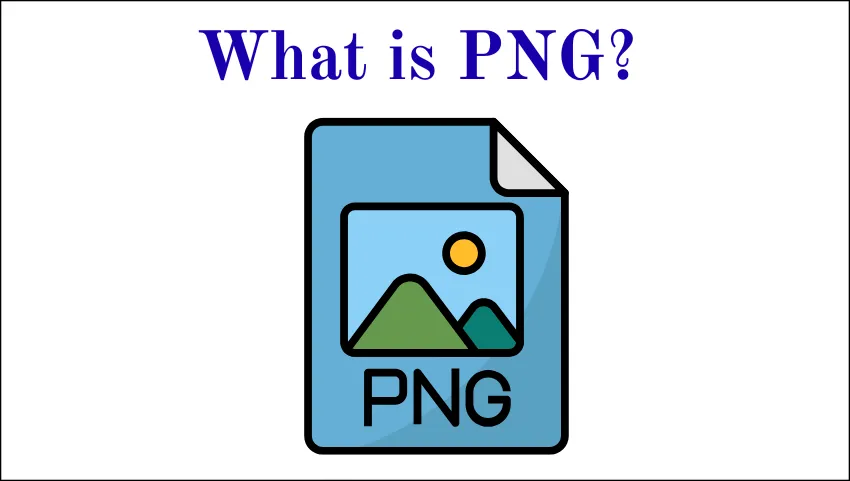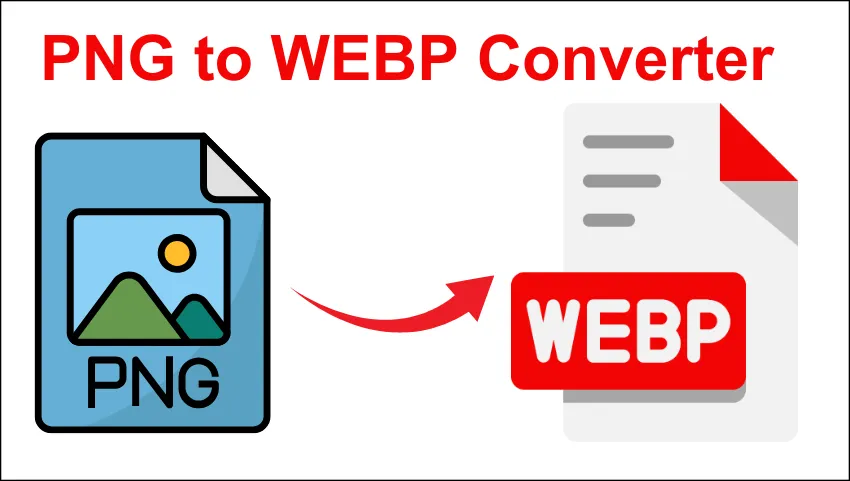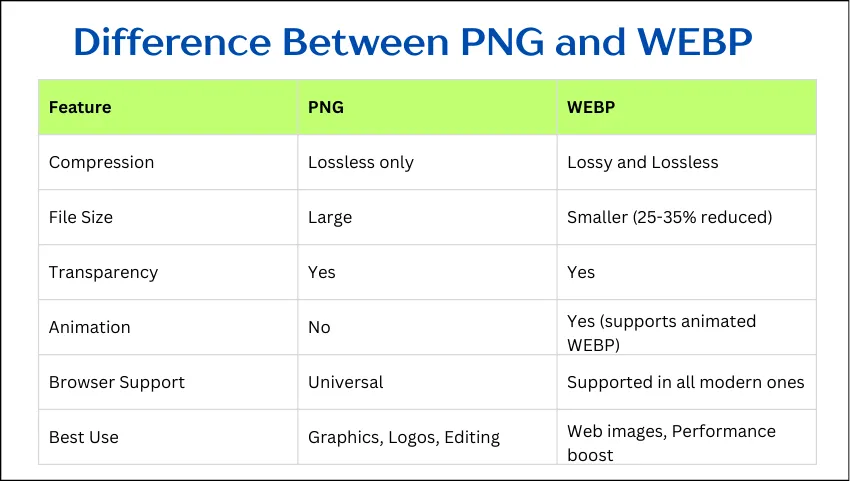PNG to WEBP Converter
Convert your PNG images to WEBP format quickly and easily
Conversion Complete!
In today’s digital world, images play an important role in websites, blogs, social media, and online marketing. But using large-size image files can slow down your website and affect performance.
To solve this problem, modern image formats like WEBP were introduced. Converting PNG images to WEBP can help you save space, improve loading speed, and enhance the overall user experience.
This detailed article will explain everything you need to know about PNG to WEBP converters, their benefits, how to use them, the top tools available, and why choosing WEBP is a smart move for any web developer, blogger, or digital creator.
What is PNG?
PNG (Portable Network Graphics) is a popular image format widely used on the internet. It was introduced in the 1990s as an improvement over GIF.

Key Features of PNG:
- Supports lossless compression, meaning quality does not get reduced after saving multiple times.
- Allows transparency in images, making it useful for logos and designs.
- Great for high-quality graphics, digital illustrations, and screenshots.
However, PNG files can be large in size, which slows down websites and increases storage requirements.
What is WEBP?
WEBP is an image format developed by Google in 2010. It is designed to make images smaller in size while maintaining high quality.
Key Features of WEBP:
- Supports both lossy and lossless compression.
- Allows animation similar to GIF.
- Supports transparency similar to PNG.
- Reduces file size by 25% to 35% compared to PNG or JPEG, without losing visible quality.
Due to these benefits, most modern browsers like Chrome, Firefox, Edge, and Opera support the WEBP format. Even WordPress and Shopify now recommend using WEBP for better site performance.
Why Convert PNG to WEBP?
Converting PNG to WEBP can provide several benefits:

- Smaller File Size: WEBP images are lighter, reducing website load time.
- SEO Advantage: Faster websites rank better in Google search results.
- Save Storage: Requires less server space, which lowers hosting costs.
- Cross-Browser Compatibility: Most modern browsers support WEBP.
- Same Quality, Less Size: Transparency and quality remain almost identical.
Example:
A 500 KB PNG file can often be compressed to 150 KB in WEBP format without any noticeable loss in quality.
Difference Between PNG and WEBP

| Feature | PNG | WEBP |
|---|---|---|
| Compression | Lossless only | Lossy and Lossless |
| File Size | Large | Smaller (25-35% reduced) |
| Transparency | Yes | Yes |
| Animation | No | Yes (supports animated WEBP) |
| Browser Support | Universal | Supported in all modern ones |
| Best Use | Graphics, Logos, Editing | Web images, Performance boost |
How to Convert PNG to WEBP?
There are several ways to convert PNG images into WEBP format depending on your needs.
1. Online Converters
These are simple websites where you upload a PNG file and download the converted WEBP image.
- Example tools: CloudConvert, Convertio.
- Pros: Easy to use, no installation needed.
- Cons: Requires internet, slow for large batches.
2. Offline Software
- Tools like IrfanView, XnConvert, or GIMP support WEBP export.
- Pros: Works without internet, batch conversion support.
- Cons: Requires software installation.
3. Command-Line Conversion
For developers, cwebp (Google’s official WEBP tool) is ideal.
Command Example:
bashcwebp input.png -o output.webpbashcwebp input.png -o output.webp
- Pros: Perfect for automation and bulk conversion.
- Cons: Requires some technical knowledge.
4. CMS Plugins
If you use WordPress or Shopify, you can install plugins that auto-convert PNGs to WEBP while uploading.
- Example: WebP Express for WordPress.
Step-by-Step: Convert PNG to WEBP Online
Here’s a simple guide for beginners:
- Visit a PNG to WEBP converter site (like Convertio or CloudConvert).
- Upload your PNG file from your computer.
- Choose WEBP as the output format.
- Click “Convert.”
- Download your WEBP file.
Within seconds, your image will be ready in a lighter format.
Advantages of Using PNG to WEBP Converter
- Saves time and effort with instant conversion.
- Allows bulk conversion of multiple images.
- Ensures no major quality loss.
- Some tools even let you adjust the compression level.
Top PNG to WEBP Converters Online
Here are some of the best online converters:
- CloudConvert—Supports multiple formats, reliable.
- Convertio—Simple drag-and-drop interface.
- ILoveIMG—Converts and edits images.
- EZGIF—Great for advanced image features.
- TinyPNG (with WEBP support)—optimizes without losing quality.
PNG to WEBP Conversion for Developers
If you are a web developer, automating PNG to WEBP conversion can save lots of work.
- Use cwebp tool in the command line.
- Integrate with Node.js sharp library.
- Automate with API services (like CloudConvert API).
Example using Node.js (sharp):
javascriptconst sharp = require('sharp');
sharp('input.png')
.toFormat('webp')
.toFile('output.webp', (err, info) => {
console.log(info);
});
Browser and Platform Support for WEBP
Currently, WEBP is supported by:
- Google Chrome
- Firefox
- Microsoft Edge
- Opera
- Safari (latest versions)
Platforms like WordPress, Shopify, Magento also support WEBP integration.
Issues You Might Face with WEBP
Although WEBP is excellent, you should be aware of a few limitations:
- Older browsers (like IE11) don’t support WEBP.
- Some editing software may not open WEBP unless you install extra plugins.
- If you use WEBP only, ensure you provide fallbacks for older browsers.
SEO Benefits of PNG to WEBP Conversion
Google recommends fast-loading websites, and images take up around 60% of a webpage’s weight. By using WEBP:
- Pages load faster.
- Bounce rate decreases.
- Ranking in Google improves.
- Better Core Web Vitals score.
According to Google Developers, WEBP reduces image size significantly without visible changes.
How to Add WEBP on Your Website
You can use WEBP images directly like PNG or JPEG:
xml<img src="image.webp" alt="Converted image">
But for cross-browser compatibility, use the <picture> tag:
xml<picture>
<source srcset="image.webp" type="image/webp">
<source srcset="image.png" type="image/png">
<img src="image.png" alt="Fallback image">
</picture>
This ensures that if WEBP is not supported, PNG is loaded.
Use Cases of WEBP
- E-commerce websites—faster product pages.
- Blogs—Lightweight blog images for SEO.
- Portfolio sites—Showcase designs without slowing down.
- News portals—Handle large amounts of images efficiently.
- Social Media – Although not all platforms accept WEBP, it works for web sharing.
Why Developers Prefer WEBP Over PNG
- Handles both lossy and lossless compression.
- Smaller size means faster APIs and mobile performance.
- Works with animations.
- Supported by next-gen optimization guidelines.
Future of WEBP
As internet users demand faster and optimized content, formats like WEBP are becoming industry standards. Google Chrome and WordPress already promote it as a “next-gen format.” Soon, PNG may be used only for editing purposes, while WEBP dominates web publishing.
FAQs About PNG to WEBP Converter
Is WEBP better than PNG?
Yes, WEBP is lighter and still maintains high quality, making it better for web usage.
Can I convert multiple PNGs to WEBP at once?
Yes, many converters and software tools support batch conversion.
Do all browsers support WEBP?
All modern browsers support WEBP, but old browsers like IE do not.
Will converting to WEBP reduce image quality?
No noticeable loss occurs if you use proper compression levels.
Can WEBP replace PNG completely?
Not entirely. PNG might still be used for editing or when transparency with absolute quality is needed.
Conclusion
The PNG to WEBP converter is a powerful solution for web developers, designers, and digital content creators who want to optimize their images without sacrificing quality. By switching to WEBP, you ensure faster websites, improved SEO, lower storage needs, and a better user experience.
So, next time you are uploading images to your website, remember to convert PNG to WEBP and enjoy the benefits of modern, optimized image formats.
